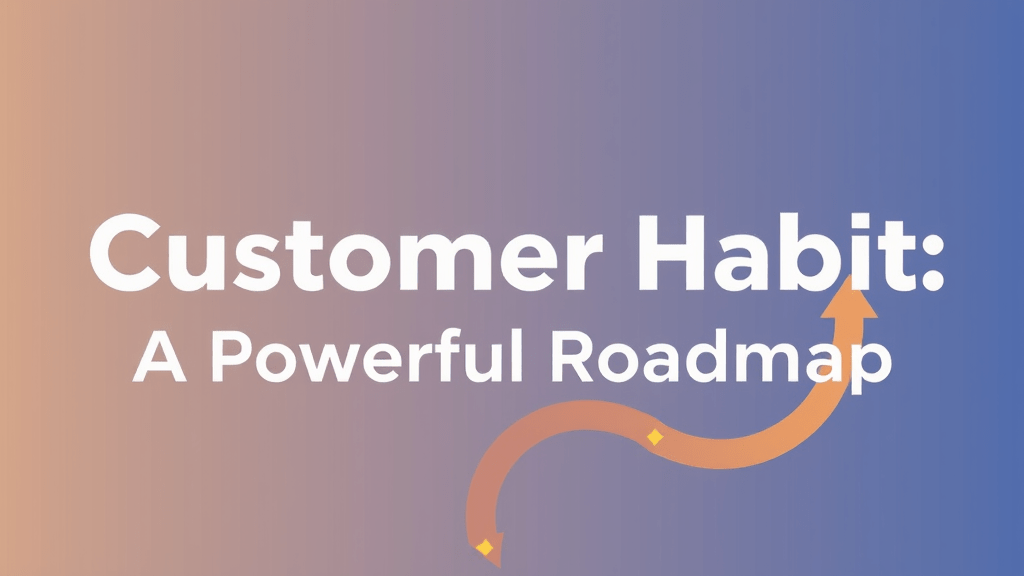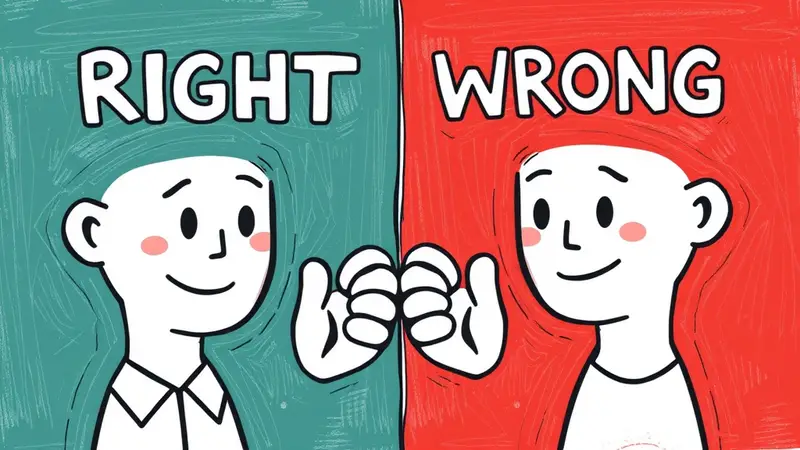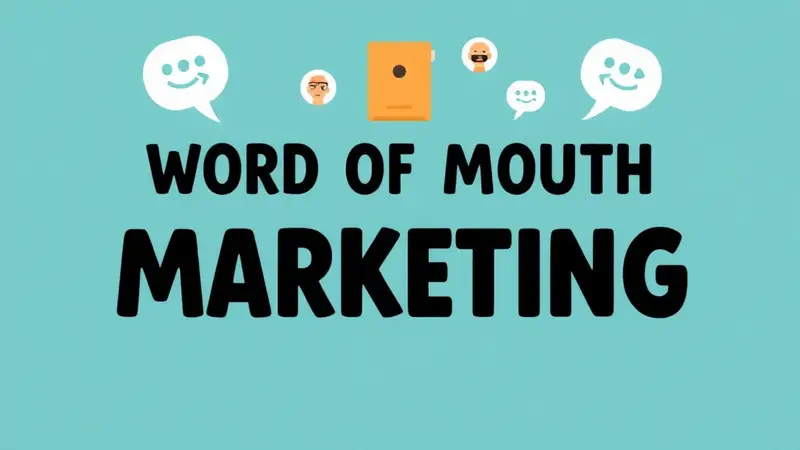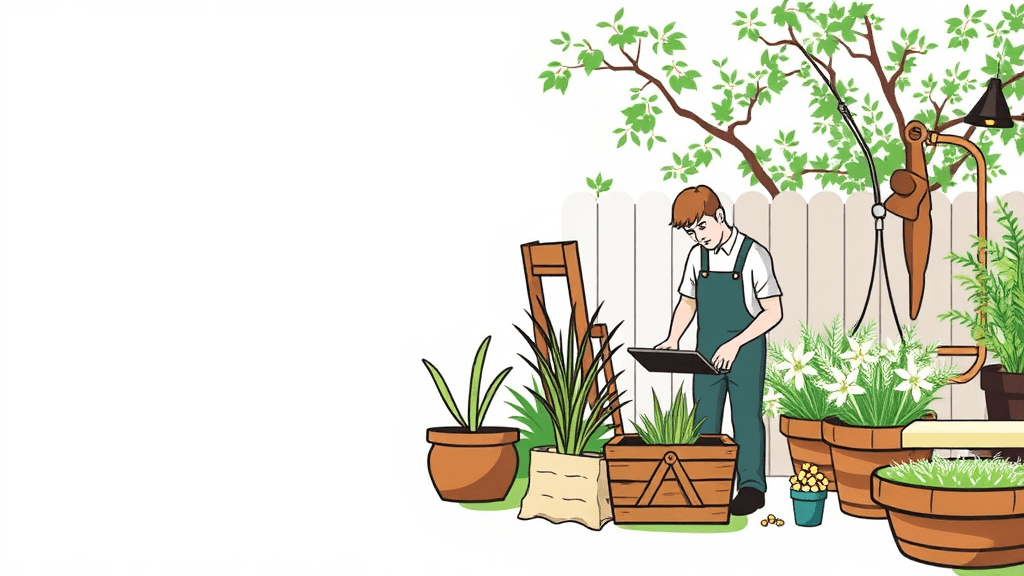Have you ever caught yourself repeatedly choosing the same coffee blend each morning or tapping open the same app whenever you have a spare moment? These small, seemingly automatic decisions can reveal an enormous secret to business success: the power of habit. When a product or service slips so seamlessly into our daily routines, it stops being a choice we weigh and becomes a reflex we simply follow. In other words, we do it out of habit. And for any small business owner, cultivating customer habits can be a game-changer—one that frees you from constantly trying to convert new buyers and allows you to thrive on consistent, repeat business.
At its core, habit formation relies on a simple loop: a trigger initiates an action, which leads to a rewarding outcome. Repeated enough times, this sequence rewires the brain so that the behavior becomes second nature. Establishing such effortless loyalty can mean the difference between a business that struggles to retain customers and one that fosters a loyal community, propelled by word-of-mouth enthusiasm. When customers automatically return to you—whether it’s for that morning latte, a social media check-in, or a quick retail therapy pick-me-up—you gain far more than a single sale. You earn the kind of brand recognition and trust that transforms your business into a fixture in people’s lives.
Throughout this guide, you’ll find practical tips, inspiring case studies, and proven approaches to help your brand stand out in a crowded marketplace. Rather than spending valuable resources chasing potential customers, you’ll learn how to guide them into a repeat-purchase pattern that ensures they stick around for the long haul. In the end, those everyday choices—like which coffee we sip or which icon we tap—can mean incredible gains for small business owners who recognize the power of turning first-time buyers into long-term regulars.
What is a Consumer Habit?
A consumer habit is a repeated purchasing or usage behavior that happens with little or no conscious thought. Unlike a casual preference or one-time choice, a habit becomes an automatic action triggered by something in the individual’s environment, mindset, or routine. This automaticity is sustained by a loop consisting of:
- Trigger: A physical location, a moment of boredom, an emotional state, or any cue that signals the brain.
- Behavior: The action taken in response to that cue, such as purchasing a favorite coffee or opening a familiar app.
- Reward: The benefit or satisfaction that follows—like the energizing effect of caffeine or the comforting sense of community when frequenting a favorite local spot.
By repeating this cycle, the individual’s mind starts to associate a positive or predictable outcome with a particular product or service. Eventually, the routine becomes so ingrained that people make the same choices without a second thought, often ignoring competitor deals or minor price changes. Habits provide comfort and stability, which is why many continue with their familiar options even when alternatives exist.
From a business standpoint, establishing consumer habits around your offering can lead to stronger brand loyalty and more consistent revenue. Rather than making conscious, day-to-day buying decisions, customers revert to their familiar loop. When your product or service is part of that loop, you become the “go-to” choice, protecting your customer base from outside influences and helping your business thrive.

Understanding Why Certain Products Become Habits
Many daily actions are guided by mental shortcuts that help our brains conserve energy. Once a particular customer habit style behavior is repeated frequently—and it consistently leads to a positive or predictable outcome—the brain treats it like a “safe bet.” Over time, the decision to pick the same coffee brand each morning happens automatically, without any conscious deliberation.
In behavioral psychology, repetition plus reward is key to forming a habit. The reward can be tangible (like the energizing taste of coffee) or intangible (like a feeling of connection when checking social media). Here’s how the cycle typically unfolds:
- Trigger: A prompt or cue, such as feeling morning fatigue or boredom.
- Behavior: The action, like brewing your go-to coffee or opening the Instagram app.
- Reward: The outcome reinforcing the behavior, such as enjoying caffeine or catching up on social updates.
With enough repetition, these actions become so ingrained that you no longer ask, “Which coffee should I drink?” or “Which app should I open?” Instead, your mind automatically chooses the familiar option.
For businesses, leveraging these customer habits and consistently providing rewarding experiences is crucial for fostering repeated engagement. This approach is especially beneficial for small businesses. By recognizing and catering to customers’ triggers—be they routine schedules or common pain points—and consistently delivering satisfying rewards, you can cultivate a loyal customer base that returns on autopilot. Even without large budgets or widespread market dominance, a focus on habit-forming strategies helps build a strong foundation of repeat buyers.
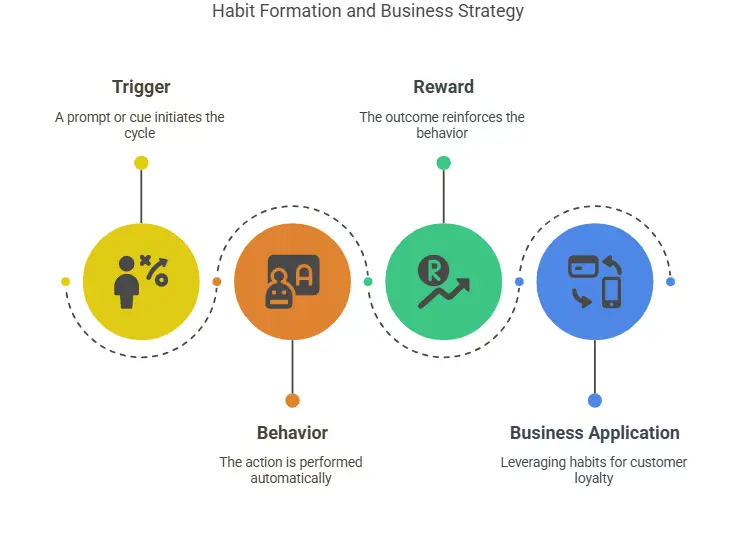
The Power of Customer Habit for Brand Loyalty
Acquiring new customers often costs significantly more than retaining existing ones. For small businesses with limited budgets, competing against large corporations for brand awareness and advertising can be tough. However, once a company establishes habitual usage, many of those cost barriers begin to fade, because the marketing almost takes care of itself. Customers who act out of habit don’t need constant persuasion, allowing the customer habit loop (trigger → behavior → reward) to become a powerful, self-sustaining growth engine.
Here’s why fostering habitual usage can give small businesses a critical edge:
- Reduced Costs: Constantly advertising to attract new customers requires substantial resources. Habitual users return on autopilot, meaning you spend less on persuasion and more on enhancing their experience.
- Organic Word-of-Mouth: Satisfied repeat customers share their routines with friends and family, offering genuine endorsements. A statement like, “I always get my bread from this local bakery,” carries more weight than a paid ad, and it costs you nothing.
- Stronger Brand Loyalty: When people form habits, they’re more reluctant to switch, even if a competitor offers a discount or promotion. The convenience and comfort of a familiar choice often outweigh any potential savings.
- Price Resilience: A strong habit loop insulates your business from aggressive price wars. If your product or service is part of someone’s daily routine, they’re less inclined to abandon it over minor cost differences.
By embedding yourself in customers’ habits, you create an enduring bond that helps your business thrive—without the constant struggle to stand out in an overcrowded market.
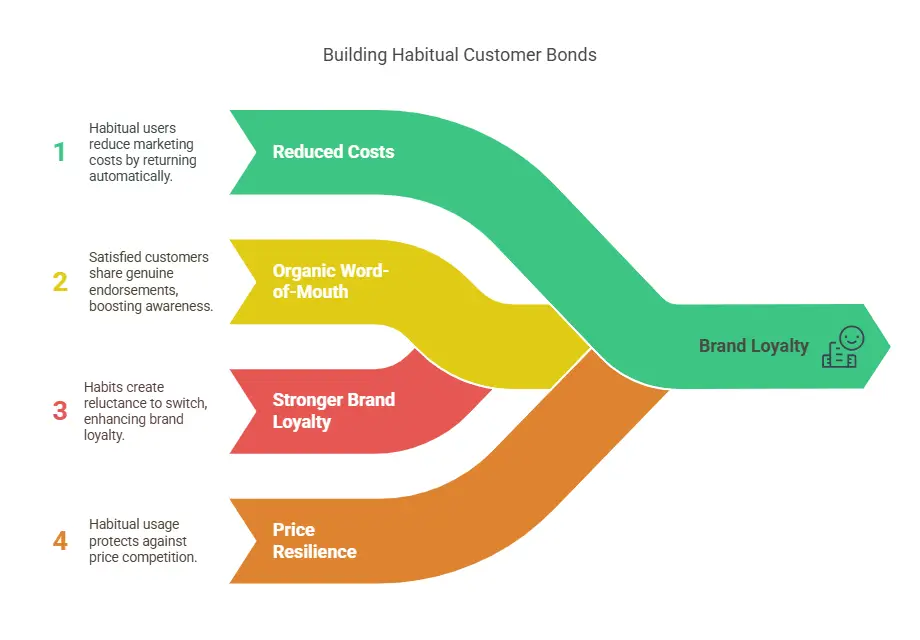
Exploring the Habit Loop for Small Businesses
The customer habit loop is frequently described in three stages: trigger, behavior, and reward. Understanding each stage is critical for small businesses looking to cultivate habitual purchasing or engagement.
- Trigger: This is the cue or stimulus that initiates the behavior. Triggers can be external—like a push notification, a location-based reminder, or a logo in someone’s line of sight—or internal, such as a feeling of fatigue, stress, or boredom. For instance, a local gym might create external triggers through well-timed text reminders or app notifications that encourage members to schedule workouts. Meanwhile, an internal trigger might be the stress relief someone seeks at the end of a workday, nudging them to head to that gym without overthinking.
- Behavior (Routine): This is the actual action you want customers to take, such as buying a product, logging in to an app, or subscribing to a service. The simpler and more frictionless the behavior, the easier it is for customers to adopt it habitually. A small business can design straightforward processes that remove unnecessary steps—like offering one-click purchasing or having a clean layout on a website—to ensure that once triggered, the action is almost effortless.
- Reward: This is the outcome that reinforces the behavior, making people more likely to repeat it in the future. Rewards can be immediate (coffee satisfaction) or delayed (the long-term health benefits of consistent workouts). In business, it might be a loyalty discount, a friendly personal greeting from staff, or the sense of achievement from finishing a certain number of classes. Whatever form it takes, the reward should be meaningful enough that customers feel gratified by their choice and want to continue the cycle.
By intentionally designing each part of this loop—recognizing the triggers, simplifying the behavior, and supplying a tangible or emotional reward—small businesses can make it more likely that customers will adopt a habit around their product or service.
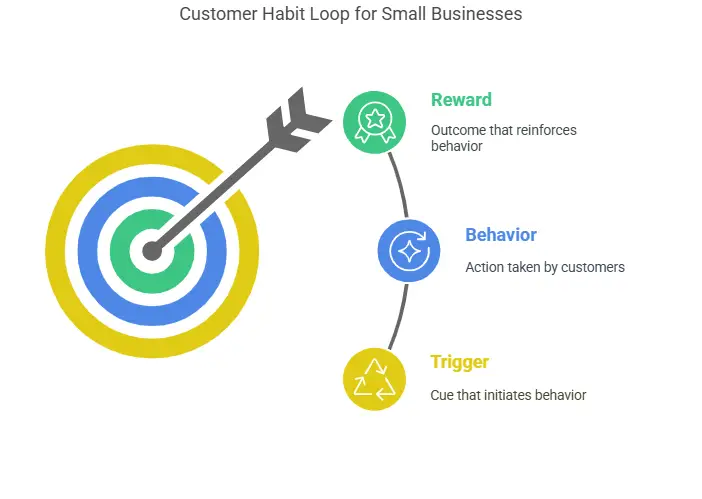
Building Habits Through Consistency
Consistency in brand message, product quality, and customer experience is a fundamental principle of habit formation. If each time a customer visits your store or uses your service, the experience meets or exceeds expectations, it encourages them to return. Conversely, inconsistent experiences can break the habit loop. A meal that’s sometimes great but sometimes poor can prevent a restaurant from becoming someone’s go-to spot. Even if the last experience was excellent, the unpredictability discourages the automatic choice.
Maintaining consistent quality might seem challenging for small businesses with fewer resources. Yet, this is exactly where attentiveness and passion often shine. Small business owners can pay closer attention to detail, maintain personal connections, and offer unique experiences that large chains may struggle to replicate. By keeping products fresh, engaging, and reliable, you help reinforce a pattern. Over time, the customer stops debating if they should come back or try somewhere new. They’ve already decided subconsciously—because their brain recognizes your establishment or product as a reliable source of satisfaction.
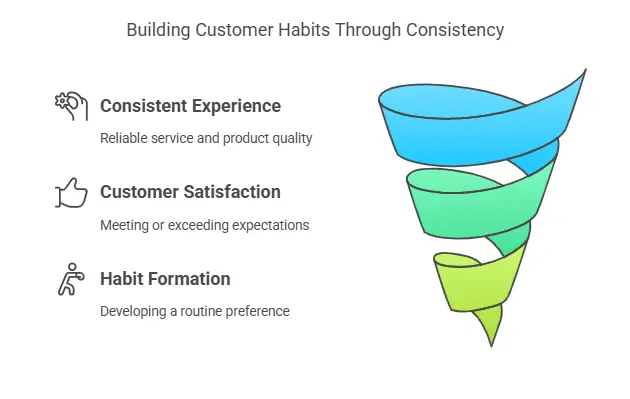
Case Study: How Starbucks Became a Habit
Although Starbucks is a massive corporation, its approach to customer habit formation is instructive for small business owners. Starbucks didn’t just sell coffee; it sold an experience that became part of people’s daily routines. Several pillars support Starbucks’ success:

- Consistency: No matter where you are, Starbucks coffee tastes the same, and the store layouts are generally familiar. This uniformity reduces decision fatigue and makes each visit feel comforting and predictable.
- Environment: The stores offer a “third place” between home and work, providing an inviting atmosphere, free Wi-Fi, and a welcoming staff. People come not only for coffee but for the ambiance and routine of spending time there.
- Rewards Program: Starbucks has one of the most recognizable loyalty programs. Frequent buyers accumulate points, which gamifies the experience and provides tangible rewards. Users are encouraged to keep purchasing to unlock free drinks and higher membership tiers.
- Brand Story: The brand focuses on delivering a sense of community and personal connection. The barista may learn your name and remember your order. This personal touch makes returning feel natural rather than forced.
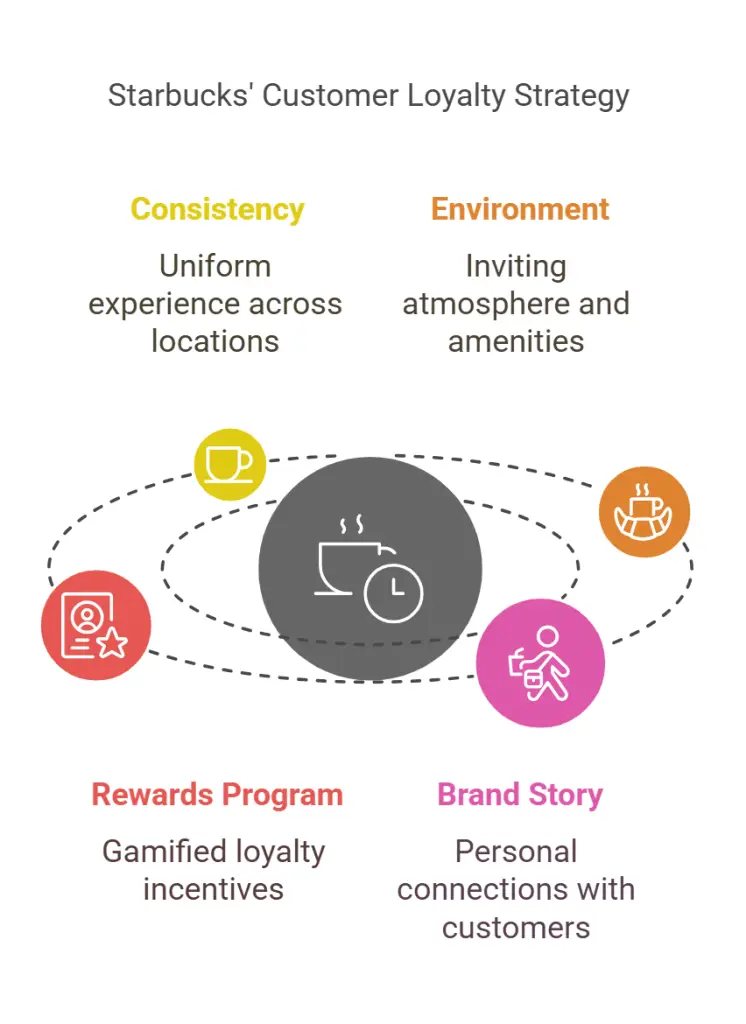
Small businesses may not replicate Starbucks in scale, but they can adopt the underlying principles: consistent product quality, a pleasant environment that resonates with the target audience, simple yet compelling loyalty incentives, and genuine personal connections. Each of these elements can fortify the habit loop.
Emotional Triggers and the Role of Storytelling
Emotions play a major role in customer habit formation. People don’t just buy products or services; they often buy experiences and solutions to emotional needs. A coffee might represent more than just caffeine—it could be a comforting ritual or a reward for starting the day early. A social media app might quell boredom or provide a sense of connectedness. A small business owner can tap into these emotional currents by telling a story around the brand that aligns with customers’ underlying needs and values.
Storytelling can involve highlighting the business’s origins, sharing the passion behind the products, or demonstrating social responsibility. For instance, a locally sourced bakery that shares photographs of the farm-fresh ingredients and the hands-on baking process can trigger emotions of trust, authenticity, and pride in supporting a local craft. When customers feel emotionally invested, they’re more likely to incorporate the brand into their routines. It becomes a statement of their personal values to choose that local bakery over a mass-produced alternative.
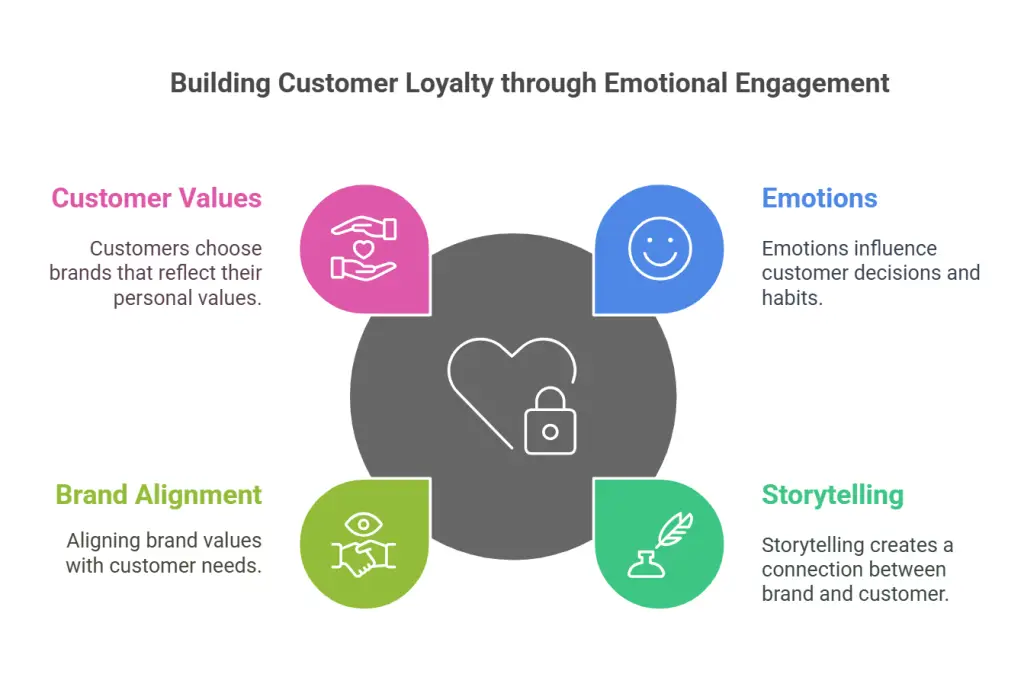
Leveraging Community and Personal Touch
One key advantage that small businesses often have over larger competitors is the ability to form personal connections with customers. While big brands may excel at consistency, many struggle to replicate the warmth of a local establishment that greets patrons by name and remembers their usual order. These small gestures convey genuine care and build strong relationships that go beyond mere transactions.
Here’s how personal connection can reinforce customer habits:
- Personal Recognition: Greeting regulars by name or noticing small changes in their routine makes them feel seen and valued.
- Emotional Payoff: Customers who feel personally cared for experience a reward in the form of recognition and appreciation, encouraging them to come back.
- Personalization: Tailoring emails, loyalty programs, and social media messages to individual preferences deepens the sense of belonging.
- Community Events: Hosting local gatherings—like art shows, open-mic nights, or fundraisers—brings neighbors together and anchors the business in the fabric of the community.
By cultivating these authentic connections, small businesses move beyond transactional interactions. In time, customers see their frequent visits not just as a purchase, but as a familiar and rewarding routine they genuinely look forward to—boosting the odds that they’ll keep coming back automatically.
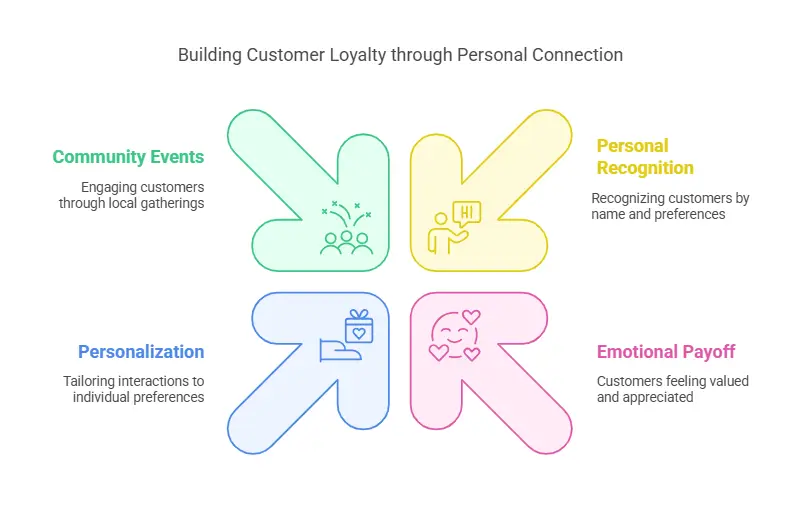
The Importance of Accessibility and Convenience
While emotional triggers and storytelling are powerful, convenience is often the deciding factor in habitual behavior. A small business, no matter how beloved, can be eclipsed if it’s consistently inconvenient to reach, or if placing orders is cumbersome. Starbucks often thrives partly because it’s on almost every corner in some cities, turning the decision to visit into the path of least resistance.
For small businesses, convenience can mean offering flexible hours that cater to the local community’s schedules, introducing delivery services for those who can’t visit in person, or having an efficient online ordering system. For example, a neighborhood restaurant might offer a streamlined pickup process and an easy-to-navigate website. A local gift shop might keep extended hours around the holidays to accommodate last-minute shoppers. Even small touches—like a dedicated parking spot for quick pickups—can make a difference. When the experience is frictionless, people are more likely to make repeat visits without consciously debating their choices every time.
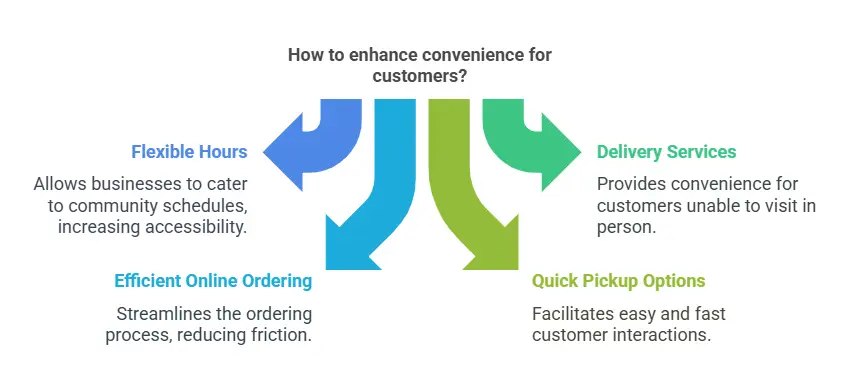
Digital Engagement and Habit-Forming Apps
Today, digital engagement channels (websites, apps, social media) are central to customer habit-building for virtually any business. Even a small brick-and-mortar store that relies on foot traffic can benefit from a robust online presence. These digital tools extend your brand’s interaction beyond the physical store and can serve as triggers that reinforce a customer habit. Push notifications, for instance, can remind customers of special offers or upcoming events, while email campaigns can share compelling stories or successes, making the emotional connection even stronger.
Social media platforms also play a potent role in cultivating customer habit. When a loyal customer follows your business on Instagram or Facebook, each post or story serves as a gentle prompt to remember your brand. That friendly nudge can be the difference between a spontaneous visit or purchase and a customer forgetting about your establishment altogether. Consistency in posting schedules, style, and messaging is just as crucial online as it is in your physical business.
For businesses that develop their own apps, customer habit design principles—like tailored notifications, streak-tracking (“You’ve visited the café 3 days in a row!”), or gamified challenges—can encourage continuous engagement. While building a custom app might be out of reach for many small businesses, a well-optimized, mobile-friendly website still provides a convenient gateway for smartphone users. By weaving your digital presence seamlessly into customers’ lives, you make it even easier for them to return—no matter where or when the urge strikes.
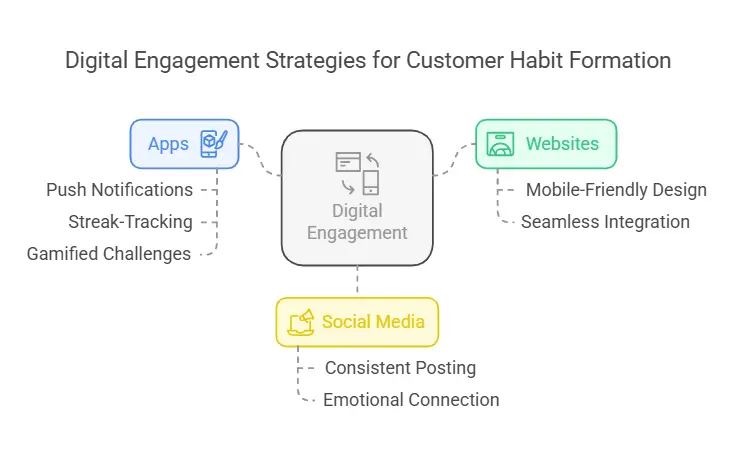
Reward Structures That Encourage Repeat Visits
Designing an effective loyalty or rewards program can be a cornerstone for driving habitual behavior. Rewards programs can take many forms, such as punch cards, point systems, tiered membership benefits, or digital platforms that track customer purchases. The key is ensuring that the reward feels attainable and aligned with what customers value. If the reward is too far out of reach or the benefits are irrelevant, customers are less likely to remain engaged.
Examples for small businesses:
- A café might offer a free pastry after the purchase of ten coffees.
- A yoga studio might provide a discounted class after a certain number of check-ins.
- A boutique clothing store could extend an exclusive invitation to a special event for loyal customers who’ve met a certain spending threshold.
Each reward system should be straightforward, appealing, and ideally personalized so that each tier or prize resonates with the target audience. Linking the reward back to the business’s main offering reinforces its perceived value. Customers not only see the benefit of continuing to make purchases, but they also feel recognized for their loyalty—an emotional satisfaction that strengthens their connection to the brand.
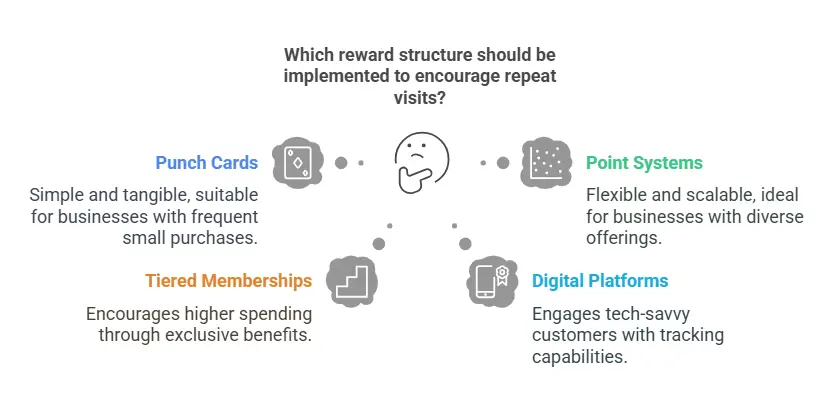
Measuring and Optimizing Habit-Forming Efforts
Small business owners can gain a significant advantage by measuring how effectively they’re nurturing a customer habit. Data might come from loyalty program sign-ups, repeat-purchase rates, social media engagement, or app analytics. By tracking indicators like how often customers return, the average time between purchases, and the percentage of shoppers who refer friends, you can tell if your strategies are successfully forming a customer habit.
Once you collect this information, the next step is to optimize. For example, if you see that people drop off after reaching a mid-level reward, it might mean that perk isn’t compelling enough to reinforce the customer habit. Or, if social media engagement is high but doesn’t convert into store visits, you may need stronger calls to action. Continuous iteration plays a crucial role in refining the customer habit loop. By adjusting triggers, simplifying the process, or improving the reward, a small business can progressively strengthen its hold on customers’ daily or weekly routines.
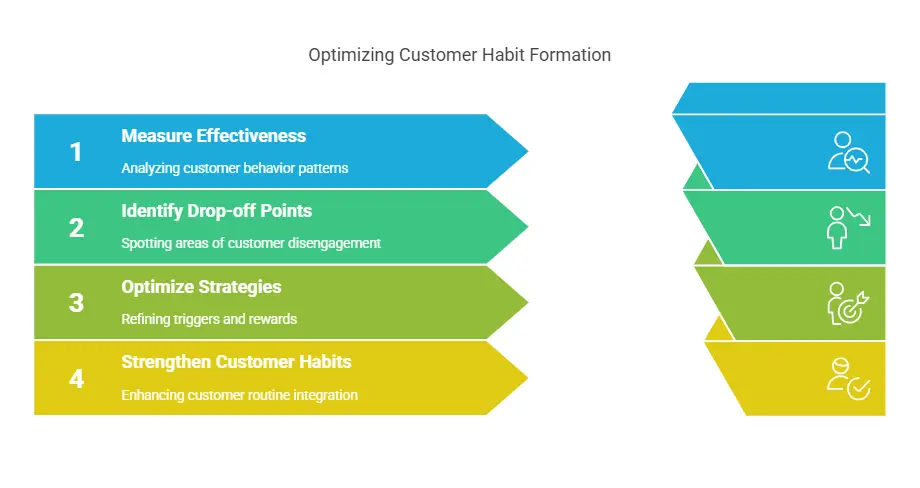
Practical Steps for Small Businesses to Begin
Identify Natural Triggers
Consider the scenarios in which your customers might think about—or need—your product or service, such as morning commuters, lunch breaks, weekend outings, or after-work relaxation. Pinning down these triggers helps you nurture a customer habit effectively.
Simplify the Action
Reduce friction wherever possible by refining your website’s navigation, store layout, or purchasing process. When the action is simple, it’s easier for a customer habit to take root.
Develop a Consistent Reward
Make sure customers see the benefit each time they purchase or engage. This could be a tangible perk—like a discount—or an intangible one—like personal recognition. Consistency reinforces the customer habit loop.
Establish a Measurable Loyalty Program
Even a simple punch card can work wonders if it’s consistently referenced by staff. More advanced digital programs can add gamification elements and automated reminders, which help anchor the customer habit in place.
Leverage Digital Platforms
Use social media, email campaigns, and possibly apps or text messaging to stay top-of-mind. Timely, relevant communication can strengthen the customer habit by triggering repeat engagement.
Gather Feedback
Collect data via surveys, social media polls, or direct conversations to understand how customers experience your brand. Armed with this insight, you can refine each element of the customer habit loop for even better results.
Foster Community
Host events, highlight user-generated content, and cultivate an environment that fosters belonging. Encouraging people to invite friends or family further cements the habit through social bonding.
Stay Adaptive
Recognize that habit formation isn’t static—customer needs change, and so does the world around them. Stay flexible, regularly assess performance, and adjust your strategies as needed.
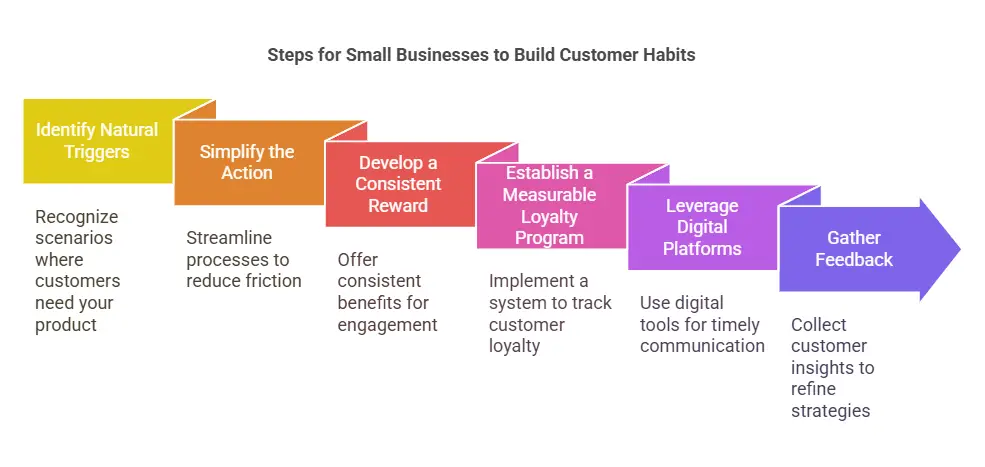
Overcoming Common Barriers to Customer Habit Formation
Despite best intentions, small businesses sometimes face challenges in turning a single purchase into a lasting habit. Limited brand visibility, inconsistent customer experiences, or overwhelming competition can hamper progress. There are a few strategies to overcome common barriers:
- Local SEO and Micro-Influencers: If you’re struggling with visibility, optimizing your online presence for local search results can be a cost-effective way to capture customers when they’re looking for solutions in your area. Partnering with local micro-influencers or community leaders can also extend your reach authentically.
- Refining the Value Proposition: If customers aren’t returning regularly, reassess what unique value you provide. Do you offer something genuinely better or different? Is your reward program compelling? Sometimes, a small adjustment—like improving store ambiance or refining product quality—makes a major difference.
- Balancing Innovation and Routine: While routine is crucial for building habits, stagnation can deter customers who crave novelty. Consider rotating specials or featuring limited-edition products while keeping your core offerings consistent. This balance ensures customers have enough familiarity to feel comforted by the routine, along with enough variation to stay intrigued.
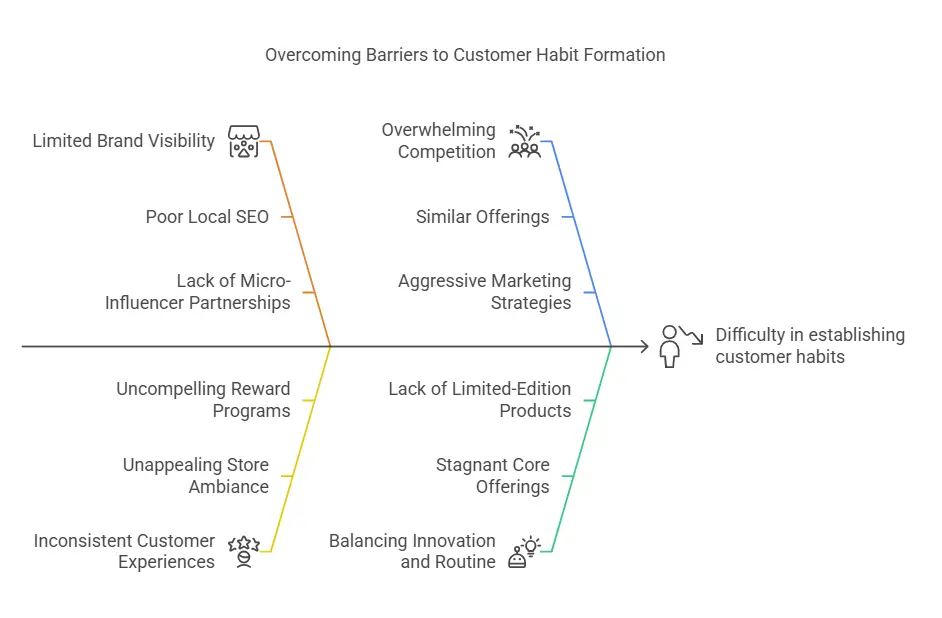
Long-Term Benefits of Creating Habitual Use
When a small business manages to convert sporadic buyers into regulars by establishing a habit, the advantages extend beyond stable income. The business gains a predictable customer base, making it easier to forecast inventory needs, staffing, and budgets. Regular feedback from loyal customers also allows the business to refine its offerings more effectively over time, as habitual users tend to share insights and suggestions.
Moreover, the sense of community that arises from strong habit-based loyalty often translates into grassroots advocacy. Loyal, habitual customers talk about the business to friends, post on social media, and even defend it if competitors arise. This stable foundation of “brand evangelists” can protect a small business from market swings and provide a much-needed buffer when disruptions occur. In essence, habitual customers become part of the brand’s narrative, continuously spreading the word and reinforcing the identity that attracted them in the first place.
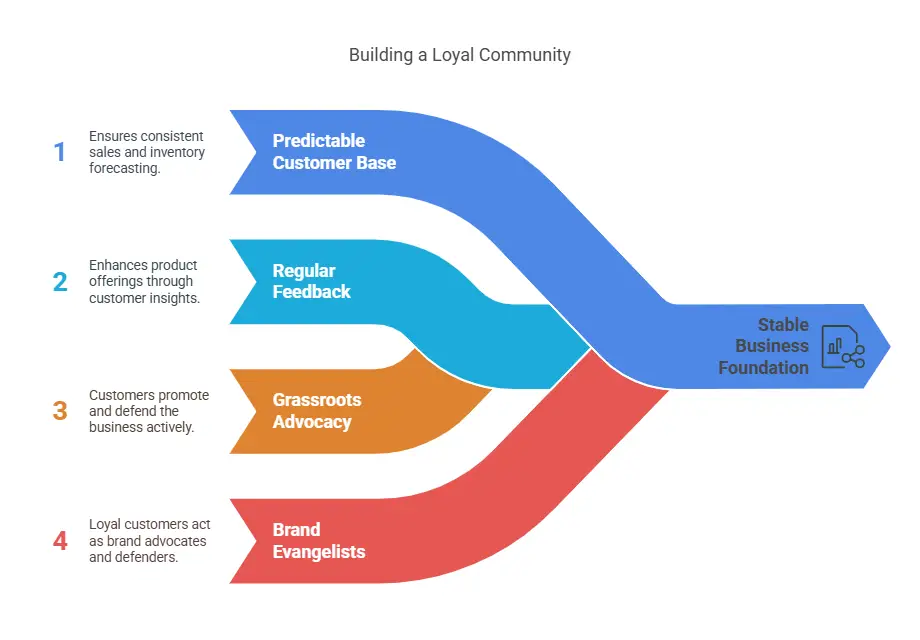
Leveraging Seasonal and Event-Based Triggers
Many habits also develop around seasonal changes or events, offering an excellent way to form a customer habit. For instance, pumpkin spice lattes are famously associated with fall, creating a Starbucks ritual among countless fans. Small businesses can adopt similar seasonal triggers—for example, a bakery might debut an autumn-themed pastry line each September to give patrons a reason to return for something timely and comforting. A gardening shop might host spring workshops to help people prepare their yards, turning a once-a-year need into a recurring customer habit that brings them back annually.
Community-focused events—like local festivals, farmers’ markets, or charity fundraisers—further reinforce habit loops. When customers start associating your brand with these recurring occasions, they begin anticipating your presence or special offers. Over time, that anticipation can transform into an automatic behavior: “It’s October again—time to head to the local craft fair and pick up those handmade soaps I love.”
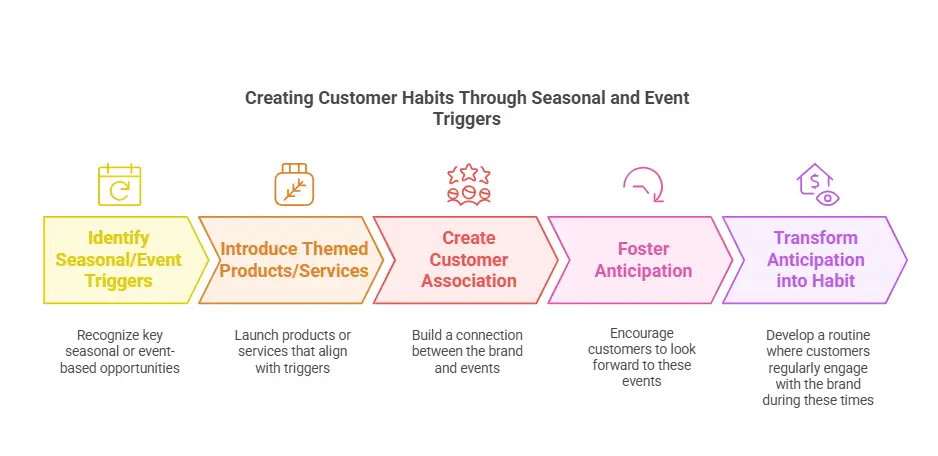
Resilience in the Face of Competition
Habits provide a protective shield against competitive pressures. When customers routinely turn to your business, they are less swayed by advertising from other brands. They have a sense of trust, familiarity, and emotional connection that a newcomer would need to work very hard to replicate. This doesn’t mean small businesses can ignore the market—only that having a habit-forming product or service can reduce the urgency of matching every competitor’s move. It gives you breathing room to improve existing offerings rather than chasing trends.
This resilience also extends to economic fluctuations. In challenging economic times, people might cut discretionary spending, but if your product or service has become part of their daily routine, they may sacrifice other luxuries first. A loyal coffee drinker might skip a vacation before giving up their daily morning latte. That consistency offers a level of financial stability that can be crucial for a small business weathering uncertain conditions.
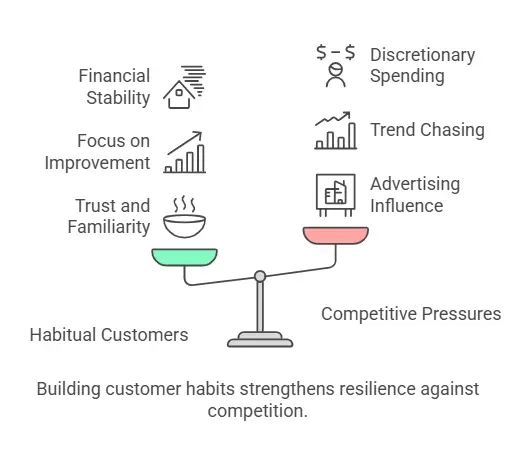
Inspiring Word-of-Mouth and Social Sharing
Small businesses often operate on limited budgets and can’t rely solely on large-scale marketing campaigns. That’s where the power of word-of-mouth comes in. Habitual customers, who engage with your product or service as part of their daily or weekly routines, naturally become your most effective brand advocates. Their personal stories carry a level of authenticity that’s hard to match with paid advertising.
Here’s how you can harness this influence:
- Authentic Endorsements: When a customer repeatedly uses your offering, their habit speaks volumes about its quality and convenience. Real-life testimonials and anecdotes resonate strongly with potential buyers.
- Social Sharing: A simple prompt—like a sign inviting patrons to tag your business on Instagram—encourages loyal customers to share their experience online.
- Routine Highlights: Many people take pride in sharing their daily habits, from morning coffee rituals to weekly lunch spots. These organic posts help spread awareness beyond your immediate circle.
- Exponential Reach: User-generated content often reaches friends and followers who trust the poster’s opinion, giving your brand exposure to new audiences without additional cost.
By tapping into customers’ established habits, you can cultivate a continuous stream of genuine endorsements that expand your reach and bolster your reputation—without investing in expensive advertising campaigns.
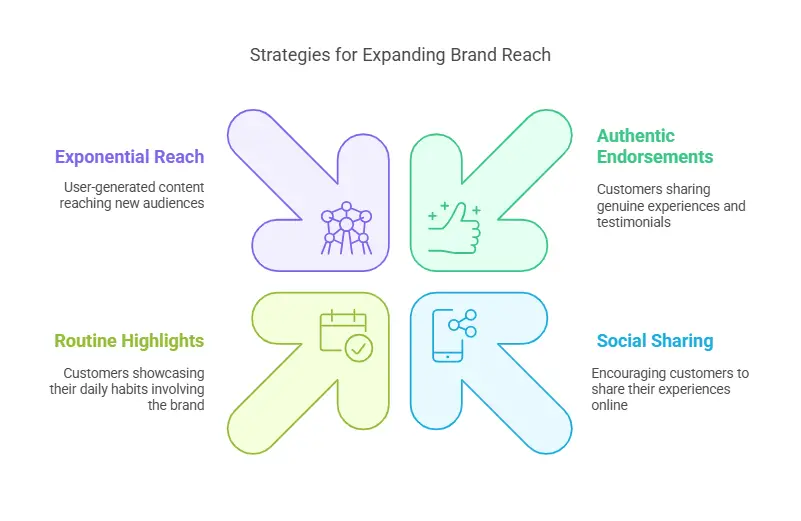
Conclusion
Every day, seemingly trivial choices—like which coffee we sip or which app we open—demonstrate the immense power of a customer habit. When a product or service becomes an automatic part of someone’s routine, that customer habit transcends the realm of casual purchases. It earns a stable place in the consumer’s life, ensuring decisions require minimal deliberation. For small business owners, mastering the art of customer habit formation means cultivating reliability, emotional resonance, and a frictionless experience that keeps customers coming back without second-guessing.
Key strategies include identifying and leveraging triggers that naturally cue customers, ensuring the core behavior or purchase is simple and consistent, and offering a clear reward—be it immediate satisfaction, emotional connection, or loyalty perks. Storytelling, community-building, convenience, and digital tools can all reinforce these customer habit loops, making your brand as much a part of the local tapestry as the morning sun and the evening breeze. Data measurement, continual feedback loops, and adaptive innovation ensure the customer habit-forming process remains relevant and effective over time.
When successful, the rewards are substantial: higher retention rates, reduced marketing costs, robust word-of-mouth promotion, and a resilient business model that can better withstand both competition and economic volatility. By weaving your brand into the fabric of customers’ daily lives, you give them one less decision to worry about—and in today’s busy world, that peace of mind can be priceless. For a small business seeking meaningful, long-term relationships with its clientele, aiming for customer habit-forming experiences is not just a strategy; it’s a blueprint for sustained success.
Frequently Asked Questions
What is a consumer habit in the context of marketing?
A consumer habit is a repeated purchasing or usage behavior that occurs with minimal conscious thought. It involves a loop of trigger, behavior, and reward, leading customers to automatically choose a product or service, fostering brand loyalty and consistent revenue.
How does the habit loop influence customer behavior?
The habit loop consists of a trigger (cue), behavior (routine), and reward. When customers repeatedly experience satisfaction from a product or service following a specific trigger, this loop reinforces automatic behavior, making them more likely to return without deliberate decision-making.
Why is building customer habits beneficial for small businesses?
Establishing customer habits leads to repeat business, enhances brand loyalty, and reduces the need for constant marketing efforts. When customers habitually choose your offerings, it results in predictable revenue streams and positions your brand as an integral part of their routines.
What strategies can small businesses use to create customer habits?
Small businesses can create customer habits by identifying triggers that prompt use, ensuring the product or service delivers consistent rewards, and encouraging repetition. Personalization, loyalty programs, and seamless user experiences also reinforce habitual engagement.
Can you provide an example of a successful customer habit-building strategy?
A coffee shop offering a morning discount can establish a routine for customers seeking daily caffeine. The consistent reward of quality coffee at a reduced price encourages repeat visits, embedding the habit of choosing that shop each morning.
Further reading
Material+, “Consumer Psychology 101: What Is a Habit?” Material+, last modified March 4, 2025, https://www.materialplus.io/perspectives/consumer-psychology-101-what-is-habit. (Accessed March 4, 2025).
The Marketing Society, “The Power of Customer Habits,” The Marketing Society, last modified March 4, 2025, https://www.marketingsociety.com/the-gym/power-customer-habits. (Accessed March 4, 2025).
Pipedrive, “Understanding Customer Behavior: A Guide for Businesses,” Pipedrive Blog, last modified March 4, 2025, https://www.pipedrive.com/en/blog/customer-behavior. (Accessed March 4, 2025).
Infiniti Research, “What Are Consumer Habits and Why Analyze Them?” Infiniti Research, last modified March 4, 2025, https://www.infinitiaresearch.com/en/sin-categoria-en/what-are-consumer-habits-and-why-analyse-them/. (Accessed March 4, 2025).
TEDx Talks, “How Habits Shape Who We Are | Samuel Salzer | TEDxHHL,” YouTube, uploaded April 4, 2023, https://www.youtube.com/watch?v=2SnT2XFX4Lc. (Accessed March 4, 2025).

